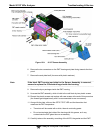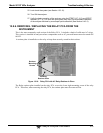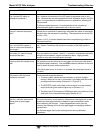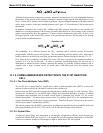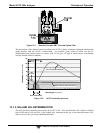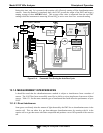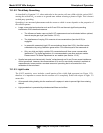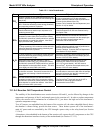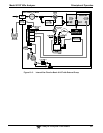
Model 9110T NOx Analyzer Principles of Operation
Teledyne Analytical Instruments 320
nm
hNONO
12002
*
2
All things being constant (temperature, pressure, amount of ozone present, etc.), the relationship between
the amount of NO present in the reaction cell and the amount of light emitted from the reaction is very
linear. If more NO is present, more IR light is produced. By measuring the amount of IR light produced
with a sensor sensitive in the near-infrared spectrum (see Figure 13-2) the amount of NO present can be
determined.
In addition, sometimes the excited NO
2
collides with other gaseous molecules in the reaction cell
chamber or even the molecules of the reaction cell walls and transfers its excess energy to this collision
partner (represented by M in the equation 12-3 below) without emitting any light at all. In fact, by far
the largest portion of the excited NO
2
returns to the ground state this way, leaving only a few percent
yield of usable chemiluminescence.
Equation 13-3
MNOMNO
2
*
2
The probability of a collision between the NO
2
* molecule and a collision partner M increases
proportionally with the reaction cell pressure. This non-radiating collision with the NO
2
* molecules is
usually referred to as third body quenching, an unwanted process further described in Section 13.1.5.2.
Even under the best conditions only about 20% of the NO
2
that is formed by the reaction described in
equation 12-1 is in the excited state. In order to maximize chemiluminescence, the reaction cell is
maintained at reduced pressure (thereby reducing the amount of available collision partners) and is
supplied with a large, constant excess of ozone (about 3000-5000 ppm) from the internal ozone
generator.
13.1.2. CHEMILUMINESCENCE DETECTION IN THE 9110T REACTION
CELL
13.1.2.1. The Photo Multiplier Tube (PMT)
The 9110T uses a special kind of vacuum tube, called a photo-multiplier tube (PMT), to detect the
amount of light created by the NO and O
3
reaction in the reaction cell.
Photons enter the PMT and strike a negatively charged photo cathode causing it to emit electrons. These
electrons are accelerated by an applied high voltage and multiplied through a sequence of similar
acceleration steps (dynodes) until a useable current signal is generated (see Section 13.5 for a more
detailed description). The more light present (in this case photons given off by the chemiluminescent
reaction described above), the more current is produced. Therefore the more NO present in the reaction
cell the more current is produced by the PMT.
The current produced by the PMT is converted to a voltage and amplified by the preamplifier board and
then communicated to the 9110T’s CPU via the A D converter circuitry on the analyzer.
13.1.2.2. Optical Filter
A high pass optical filter, only transparent to wavelengths of light above 645nm, placed between the
reaction cell and the PMT (see Figure 13-1) in conjunction with the response characteristics of the PMT
creates a very narrow window of wavelengths of light to which the 9110T will respond.




